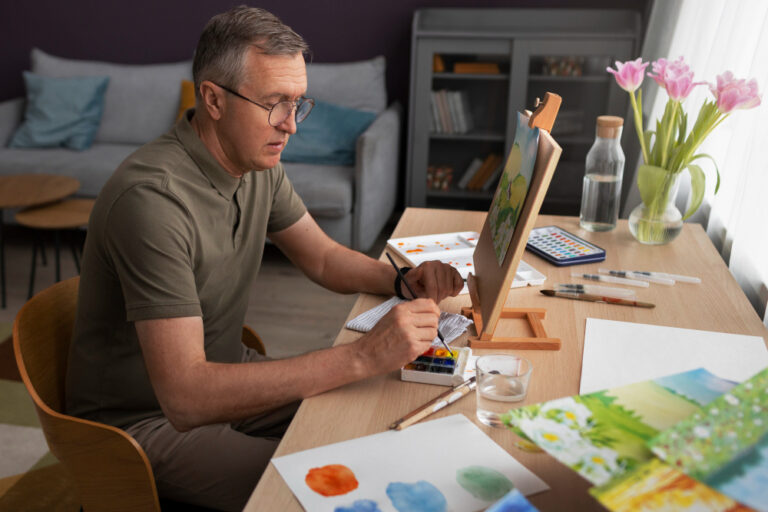
Have you ever been pouring your heart out to someone, only to see their eyes glaze over as they subtly glance at their phone? Or found yourself in a video call, supposedly collaborating, while half the participants are clearly multitasking, their attention fragmented by other tabs and notifications? Perhaps you’ve felt the sting of being completely misunderstood via text, simply because the nuances of your tone were lost in translation. In our hyper-connected, constantly buzzing world, the simple act of truly listening feels like a fading art form. We are ‘hearing’ more than ever, bombarded with information, but are we truly listening?
Active listening, the skill of fully concentrating on, understanding, responding to, and remembering what is being said is more crucial than ever for building strong relationships, fostering empathy, and navigating our complex world effectively.
Yet, the very technologies designed to connect us often erect barriers to this fundamental human skill. This guide explores The Art of Active Listening in the Digital Age, delving into what it truly means, why it’s facing unprecedented challenges today, its enduring importance, and practical techniques to cultivate this invaluable skill, both online and off.
Master Active Listening in the Digital Age: Connect Better

Active listening is fundamentally different from passive hearing. Hearing is a physiological process – the reception of sound waves. Listening, especially active listening, is a conscious psychological and cognitive process requiring intentional effort, focus, and engagement. It’s about being fully present with the speaker, seeking to understand their message from their perspective, not just waiting for your turn to talk or filtering their words through your own biases.
Key components of active listening include:
- Paying Attention: Giving the speaker your undivided focus, minimizing internal and external distractions. This involves conscious effort to stay present.
- Withholding Judgment: Listening with an open mind, setting aside preconceived notions or biases, and avoiding premature conclusions or interruptions.
- Reflecting & Paraphrasing: Verbally confirming your understanding by restating the speaker’s message in your own words (“So, if I understand correctly, you’re feeling…”).
- Clarifying: Asking open-ended questions to ensure comprehension and encourage elaboration (“Could you tell me more about…?”, “What did that mean for you?”).
- Summarizing: Periodically summing up the main points to ensure alignment and structure the conversation.
- Responding Appropriately: Showing you’ve heard and understood through verbal and non-verbal cues (nodding, empathetic sounds, thoughtful replies).
- Remembering: Retaining the core message and key details shared by the speaker.
Active listening isn’t a passive reception; it’s a dynamic, engaged process that makes the speaker feel genuinely heard and understood.
The Digital Fog: Why Real Listening is Harder Today

The digital age, while connecting us in unprecedented ways, has simultaneously created significant challenges for deep, active listening. We’re navigating a veritable “digital fog” of distractions and communication shifts.
- Constant Distractions: Smartphones are perhaps the biggest culprits. The constant stream of notifications, the lure of social media feeds, the habit of multitasking – these relentlessly fragment our attention, making it incredibly difficult to stay fully present in a conversation, whether in person or online. The average person checks their phone hundreds of times daily.
- Erosion of Attention Spans: The rapid-fire nature of online content consumption (short videos, scrolling feeds) may be conditioning our brains for shorter attention spans, making sustained focus during longer conversations more challenging.
- Lack of Non-Verbal Cues Online: As discussed previously regarding texting, much digital communication (email, text, sometimes even low-quality video) lacks the crucial non-verbal cues – tone, facial expression, body language.This forces interpretation and increases the likelihood of misunderstanding.
- The Pressure for Immediacy: Digital culture often implies an expectation of instant responses, discouraging thoughtful pauses for reflection or deeper listening before replying related context).
- Echo Chambers & Reduced Empathy: Social media algorithms can create echo chambers where we primarily encounter views similar to our own. This can reduce our exposure to differing perspectives and potentially decrease our capacity or willingness to listen empathically to those who think differently.
These factors combine to make mindful, active listening a skill that requires more conscious effort and cultivation today than ever before.
Read more: 10 Tips for Effective Communication in the Age of Social Media
The Connection Cure: Why Active Listening Matters More Than Ever

In an era marked by digital noise and potential disconnection, mastering active listening isn’t just a ‘soft skill’; it’s a vital competency with profound benefits across all areas of life.
- Stronger Relationships: Feeling truly heard and understood is fundamental to building trust, intimacy, and connection in personal relationships. Active listening validates the speaker’s experience and fosters emotional safety.
- Reduced Conflict & Misunderstandings: By ensuring clear comprehension and understanding different perspectives, active listening directly reduces misinterpretations that lead to arguments and conflict.
- Increased Empathy & Compassion: Truly listening to understand another’s experience naturally cultivates empathy and compassion, bridging divides and fostering kindness.
- Improved Learning & Information Retention: Paying full attention allows you to absorb and retain information more effectively, whether in academic settings, workplace training, or simply learning from others’ experiences.
- Enhanced Workplace Effectiveness: In professional contexts, active listening builds rapport with colleagues and clients, improves teamwork and collaboration, facilitates better problem-solving, fosters psychological safety, and is a key leadership skill. Leaders who listen are perceived as more effective.
- Personal Growth: Listening actively to feedback (without defensiveness) and to your own inner voice (self-awareness) is crucial for personal growth and development.
In a world craving genuine connection, the ability to truly listen is perhaps one of the most valuable gifts we can offer ourselves and others.
Tuning In: Core Techniques for Cultivating Active Listening

Active listening is a skill that can be learned and honed with practice. Here are core techniques to cultivate:
- Pay Full Attention: Minimize distractions. Put away your phone (or turn off notifications). Make eye contact (if culturally appropriate). Orient your body towards the speaker. Silence your internal chatter and focus solely on them.
- Show You’re Listening (Non-Verbally): Use cues like nodding, leaning slightly forward, and maintaining an open posture to signal engagement. Mirroring subtly can build rapport.
- Withhold Judgment & Advice (Initially): Listen to understand first, not to evaluate, critique, or immediately offer solutions. Allow the speaker space to fully express themselves without interruption.
- Reflect & Paraphrase: Periodically restate what you heard in your own words. “So, it sounds like you’re feeling frustrated because…” or “If I’m understanding correctly, the main issue is…” This confirms understanding and shows you’re engaged.
- Ask Clarifying & Open-Ended Questions: Don’t pretend to understand if you don’t. Ask questions that invite elaboration, not just ‘yes’ or ‘no’ answers. “Can you tell me more about that?” “How did that make you feel?” “What happened next?”
- Summarize Key Points: Briefly recap the main themes or decisions at appropriate points or at the end of the conversation to ensure mutual understanding and closure.
- Listen for Feelings & Needs: Pay attention not just to the words, but the underlying emotions and unmet needs being expressed. Acknowledge these empathetically (“That sounds really difficult,” or “I can see why you’d feel that way”).
Practice these techniques consistently, and they will become more natural over time.
Silencing the Static: Disconnecting for Deeper Listening

The single most impactful action you can take to improve your active listening, especially in the digital age, is to consciously minimize digital distractions. True presence requires freeing your attention from the constant pull of the online world.
- Put Devices Away: When engaging in a meaningful conversation (in person or even during a call), physically put your phone out of sight or turn it face down. Close unnecessary tabs on your computer during video calls. The mere presence of a phone can subconsciously reduce connection quality.
- Manage Notifications: Turn off non-essential notifications permanently or use ‘Do Not Disturb’ modes during conversations. Schedule specific times to check messages rather than reacting instantly.
- Single-Tasking: Resist the urge to multitask while someone is speaking to you. Don’t check email during a video call, scroll social media while on the phone, or type unrelated messages while listening in person. Give the conversation your full cognitive resources.
- Create Tech-Free Zones/Times: Designate certain times (like mealtimes) or spaces (like the bedroom) as device-free zones to encourage focused interaction.
- Model the Behaviour: Be the listener you wish others were for you. When you consistently offer your undivided, unplugged attention, it sets a powerful example and encourages reciprocity.
Silencing the digital static isn’t just about politeness; it’s about creating the necessary mental and environmental conditions for deep listening and genuine connection to occur.
The Art of Active Listening in the Digital Age: Adapting Online

While face-to-face interaction is ideal for active listening due to the full range of cues, we inevitably communicate digitally. How can we adapt these skills online?
Video Calls:
- Maximize Visuals: Encourage cameras on when appropriate. Look at the camera periodically to simulate eye contact. Pay attention to the facial expressions and limited body language visible.
- Minimize Distractions: Close other tabs/apps. Use headphones to block external noise and improve audio clarity. Mute yourself when not speaking to reduce background noise for others.
- Verbalize Cues: Since non-verbals are limited, use more verbal affirmations (“Mhmm,” “I see,” “That makes sense”) to show engagement.
- Paraphrase & Summarize More: Due to potential audio lags or distractions, frequently paraphrasing and summarizing is even more critical to ensure mutual understanding.
Text & Email:
- Read Carefully & Slowly: Resist skimming. Pay attention to word choice and any attempts to convey tone (emojis, punctuation).
- Acknowledge Receipt: A simple “Got it, thanks” or “Thanks, reading now” can prevent the sender from feeling ignored.
- Clarify Proactively: If anything is unclear or ambiguous, ask for clarification before reacting or assuming. “Just to clarify, did you mean X or Y?”
- Inject Empathy (Carefully): Use empathetic language where appropriate, acknowledging the other person’s likely perspective or feeling (“I can imagine that must be frustrating,” “I understand you’re busy…”).
- Know When to Switch: Recognize immediately if a topic becomes complex, emotional, or contentious, and suggest a voice or video call (See previous post on text misunderstandings).
Adapting active listening online requires more conscious effort to compensate for the limitations of the medium, focusing heavily on clarity and verbal expressions of understanding and empathy.
Common Concerns & Solutions for Aspiring Active Listeners

Cultivating active listening takes practice and awareness. Here are common challenges:
Concern 1: “I get distracted easily / My mind wanders.”
- Solution: This is normal! Treat it like meditation: gently notice your mind has wandered, acknowledge the thought without judgment, and consciously redirect your focus back to the speaker and their words. Practice mindfulness exercises outside of conversations to strengthen your attention muscle. Minimizing external distractions helps immensely.
Concern 2: “What if the speaker is genuinely boring or rambling?”
- Solution: Find a point of genuine curiosity. Ask clarifying questions that might steer the conversation slightly or help you understand their perspective better. Practice patience. Focus on their experience of sharing, even if the content isn’t gripping for you. You can also politely set time boundaries if needed (“I only have about 10 more minutes, but I’d love to hear the main point you wanted to share”).
Concern 3: “How can I listen actively in noisy group chats or busy video calls?”
- Solution: It’s challenging! Focus on one speaker at a time if possible. Use visual cues on video calls (speaker view). Mute yourself to focus better. In text chats, read carefully before responding, and perhaps summarize points occasionally to ensure group understanding. Acknowledge that deep listening is harder in these formats.
Concern 4: “Is true active listening really possible online with the lack of cues?”
- Solution: While it’s definitely harder and some depth is inevitably lost compared to in-person, practicing the core techniques (attention, paraphrasing, clarifying, empathy through words) makes online listening significantly better than passive hearing or distracted engagement. Focus on compensating verbally and being extra intentional.
Active Listening Practice Checklist

Keep these key practices in mind for your next conversation:
- Minimize Distractions: Put phone away/silent, close unnecessary tabs.
- Be Present: Focus your mental attention fully on the speaker.
- Open Body Language: Face the speaker, maintain comfortable eye contact (as appropriate), use open posture.
- Listen to Understand: Set aside judgment and your own agenda temporarily.
- Notice Non-Verbals (If available): Pay attention to tone, expression, posture.
- Avoid Interrupting: Let the speaker finish their thoughts (except for brief clarifying questions).
- Reflect/Paraphrase: Occasionally restate their points in your own words to check understanding.
- Ask Clarifying Questions: Use open-ended questions if something is unclear.
- Show Empathy: Acknowledge their feelings (“That sounds frustrating”).
- Summarize (If helpful): Briefly recap main points, especially in longer conversations or meetings.
- Respond Thoughtfully: Ensure your response shows you’ve heard and considered their perspective.
The Greatest Gift: To Truly Listen and Be Heard

In a world clamoring for attention, offering someone your full, undivided presence through active listening is one of the most profound gifts you can give. It says, “I see you. I hear you. You matter.” The Art of Active Listening in the Digital Age requires conscious effort to cut through the static, manage distractions, and adapt timeless communication principles to modern mediums. It demands patience, empathy, and a genuine desire to understand.
You’ve explored the core components of active listening, recognized the unique challenges posed by our digital environment, understood its immense benefits, and learned practical techniques to cultivate this skill both online and off.
Mastering active listening is not just about becoming a better communicator; it’s about becoming a more connected, empathetic, and present human being. It strengthens relationships, deepens understanding, and ultimately, enriches our own lives by allowing us to truly receive the perspectives and experiences of others.
How will you practice active listening today? Perhaps start by putting your phone completely away during your next conversation, or by consciously paraphrasing what someone says to ensure you’ve understood. Choose one technique and practice it with intention. The journey to becoming a better listener starts now, and the rewards – for you and for those you connect with – are immeasurable.






